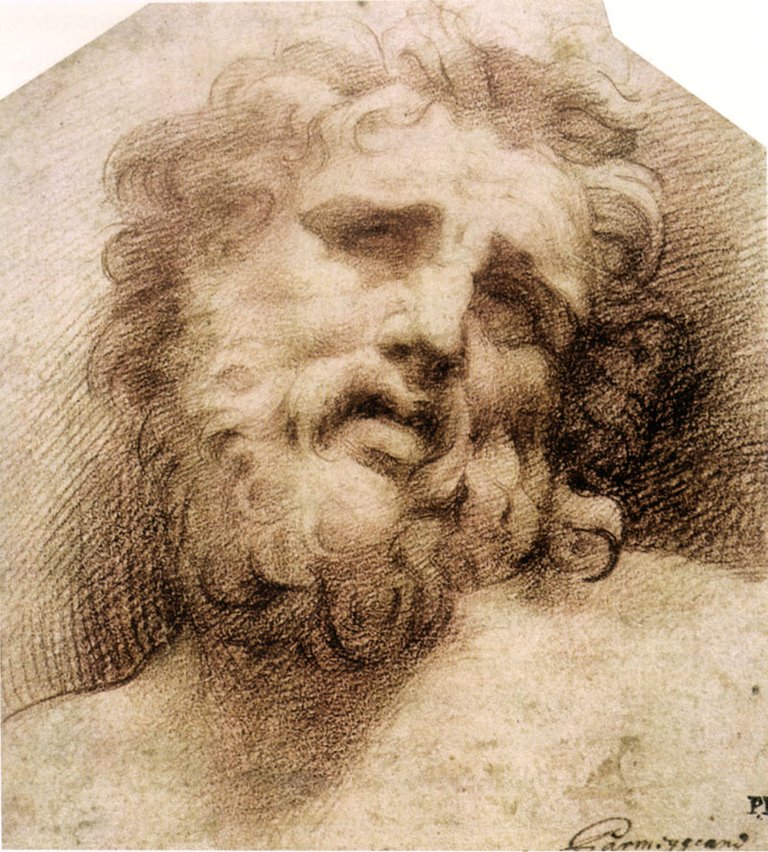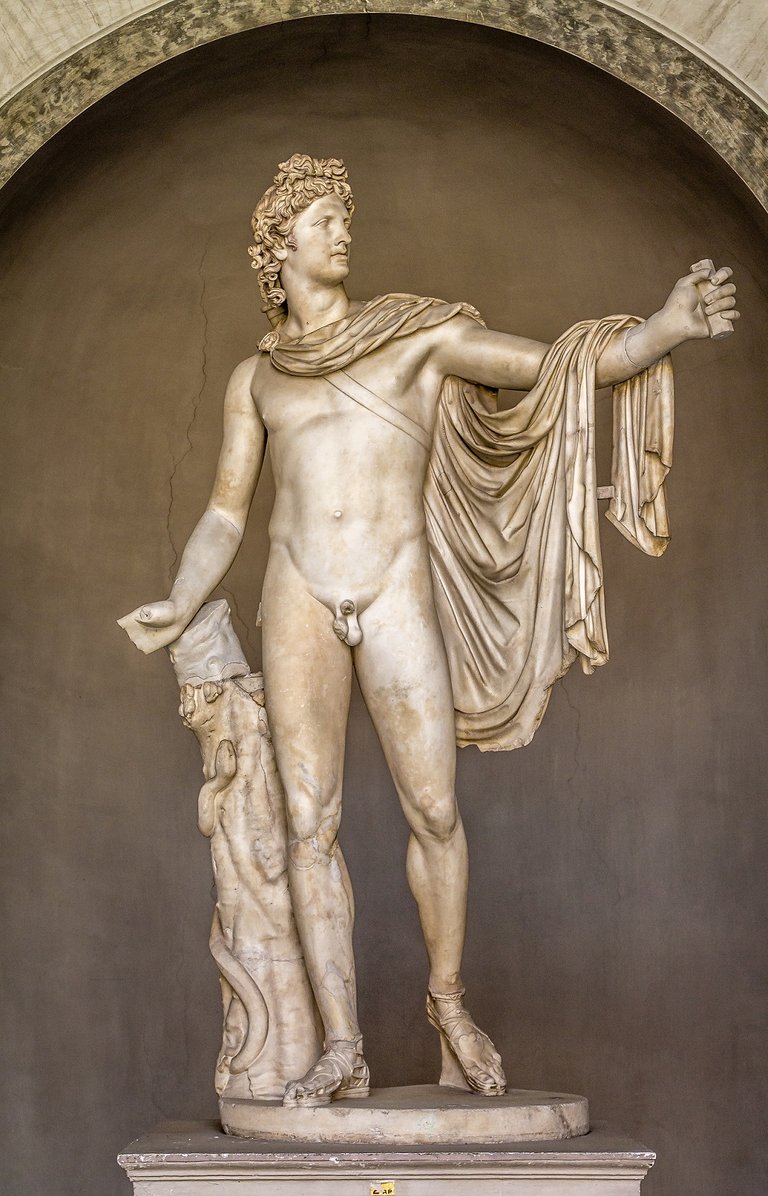
Wonderful sculptures that founded the Vatican Museums.
Today I return to talk to you about art history, dealing with the theme of late Hellenistic classical sculpture.
I share a beautiful series of images of the Laocoon marble group, a work of art that influenced all Renaissance sculpture and a large part of Baroque and Neoclasicism.
In reality these two statues found in the 1500s influenced all art starting from the Renaissance, the first; Apollo of the Belvedere, found in the excavations of Anzio in 1496
and the second, the Laocoon group found near the Domus Aurea in Rome in 1506.
In the excavations for the recovery of Laocoon even the great genius Michelangelo and the great architect Giovanni da Sangallo assisted, both assessed the immense importance of the masterpiece for Pope Julius II, a great lover and collector of ancient art.

Last Judgement - Michelangelo - Sistine Chapel
The two artists fully agreeing with the writings of Pliny the Elder famous writer, philosopher and naturalist who lived in the first century after Christ, and attributed the work to the Hellenistic sculptors Hagesandros, Athenedoros, and Polydoros.
Pope Julius II immediately acquired ownership of the two sculptures and included them in his collection within the large complex of the Belvedere Garden, a wing north of the Basilica of San Pietro courtyard designed by Donato Bramante, destined to become one of the most important museums in the world.
These two works marked the beginning of the famous Vatican Museums and for many centuries they were visited by travelers, artists and writers of all backgrounds.

Belvedere courtyard - Vatican Museums
Even today they are among the most important pieces of the Vatican Museums collection.

Vatican Museums Spiral Staircase
Who was Laocoon?
This man was a character from Greek mythology, the priest and seer of Poseidon or Apollo.
In the Aeneid we read that Laocoon threw a spear against the wooden horse brought inside the city of Troy, screaming that the spear had made the belly of the horse resonate full, therefore false and said the famous phrase "Beware of Greeks bearing gifts ".

Parmigianino - Laocoon head -16th century
None of the Trojans listened to him and the goddess Pallas Athena who sided with the Greeks punished Laocoon by sending two large sea snakes who crushed the priest's two sons and also killed the man who had run to the aid of his children.
The scene that lends itself before our eyes is dramatic and at the same time emphasized by very theatrical attitudes and expressions of faces.
None of the Trojans listened to him and the goddess Pallas Athena who sided with the Greeks punished Laocoon by sending two large sea snakes who crushed the priest's two sons and also killed the man who had run to the aid of his children.

Alexis François Girard - Laocoon -
19th century - engraving
It is undoubtedly the most technically virtuous sculptural group in history, the muscular contortions of the poor protagonists merge with the coils of the two sea snakes.
But the tension of the father's muscle masses is enhanced by the poignant features of the face, which seems to be melting with suffering.

El Greco - Laocoon - detail - oil on canvas -1604
Think that this in the Vatican Museums is the marble copy made by Roman sculptors, of the bronze original which had a lost wax casting, therefore of enormous technical difficulty.
The Laocoon will also be the main source of inspiration for the genius of art history Michelangelo Buonarroti who was struck by the expressive power of the priest's face and the muscular tensions of man.
I leave you with other images of works inspired by the Laocoon.
A hug.
Armando.

Michelangelo - Dying Slave - marble

Caricature of the Laocoon group as apes
Artist unknown, possibly Niccolo Boldrini 16th century.

Claesz Soutman Laocoön - oil on canvas - 1657

Bust of Laocoon - Rafael Romero de Torres -
graphite pencil on paper - 1888

Detail of the monument to Laocoon in San Paolo - Brazil
Sculture meravigliose che hanno fondato i Musei Vaticani.
Oggi torno a parlarvi di storia dell'arte, affrontando il tema della scultura classica tardo-ellenistica.
Vi condivido una bella serie di immagini del gruppo marmoreo di Laocoon, opera d'arte che ha influenzato tutta la scultura rinascimentale e di buona parte del barocco e del Neoclasicismo.
In realtà queste due statue ritrovate nel 1500 hanno influenzato tutta l'arte a partire dal rinascimento, la prima; Apollo del Belvedere, trovata negli scavi di Anzio nel 1496 e la seconda, il gruppo del Laocoonte trovata vicino alla Domus Aurea a Roma nel 1506.
Negli scavi per il recupero del Laocoonte assistì addirittura il sommo genio Michelangelo e il grande architetto Giovanni da Sangallo, entrambi ne valutarono l'immensa importanza del capolavoro per il papa Giulio IIgrande appassionato e collezionista di arte antica.
I due artisti concordando in pieno con gli scritti di Plinio il Vecchio famoso scrittore, filosofo e naturalista vissuto nel primo secolo dopo Cristo, e attribuirono l'opera agli scultori ellenistici Agesandro, Atenodoro, e Polidoro.
Il papa Giulio II ne acquisì subito la proprietà delle due sculture e le inserì nella sua collezione all'interno del grande complesso del Giardino del Belvedere, un'ala a nord della basilica di San Pietro cortile progettato da Donato Bramante, destinato a diventare uno dei musei più importanti del mondo.
Queste due opere segnarono l'inizio dei famosissimi Musei Vaticani e per molti secoli furono oggetto di visite da parte di viaggiatori, artisti e letterati di ogni provenienza.
Ancora oggi sono tra i pezzi più importanti della collezione dei Musei Vaticani.
Chi era Laocoonte?
Quest'uomo fu un personaggio della mitologia greca,
il sacerdote e veggente di Poseidone o di Apollo.
Nell'Eneide leggiamo che Laocoonte scagliò una lancia contro il cavallo di legno portato all'interno della città di Troia, urlando che la lancia aveva fatto risonare il ventre del cavallo pieno, quindi falso e disse la celebre frase "Temo i Greci quando portano i doni" "Beware of Greeks bearing gifts"
Nessuno dei troiani lo ascoltò e la dea Pallade Atena che parteggiava per i greci punì Laocoonte inviando due grandi serpenti marini che stritolarono i due figli del sacerdote e uccidendo anche l'uomo che era corso in aiuto dei figli.
La scena che si presta davanti ai nostri occhi è drammatica e al tempo stesso enfatizzata da atteggiamenti ed espressioni dei visi molto teatrali.
Indubbiamente è il gruppo scultoreo tecnicamente più virtuoso della storia, i contorcimenti muscolari dei poveri protagonisti si fondono con le spire dei due serpenti marini.
Ma la tensione delle masse muscolari del padre viene esaltata dai lineamenti struggenti del viso, che sembra si stia sciogliendo per la sofferenza.
Pensate che questa presente nei Musei Vaticani è la copia in marmo eseguita da scultori romani, dell'originale in bronzo che ha avuto una fusione a cera persa, quindi di enorme difficoltà tecnica.
Il Laocoonte sarà la principale fonte di ispirazione anche per il genio della storia dell'arte Michelangelo Buonarroti che rimase colpito dalla forza espressiva del volto del sacerdote e dalle tensioni muscolari dell'uomo.
Vi lascio con altre immagini di opere ispirate dal Laocoonte.
Un abbraccio.
Armando.

my Facebook page: https://www.facebook.com/armando.sodano


Art teacher
Curator of cultural activities
Artistic director and President of the Cultural Association "I Colori della Vita"
https://www.icoloridellavita.life/
and "Fuori Controllo" Festival
 https://www.facebook.com/fuoricontrollofestival/
https://www.facebook.com/fuoricontrollofestival/





Yay and art history lesson and about one of my favorite sculptures! I especially liked the art inspired by the Laocoon. That was very interesting. I was able to visit the Vatican last May and saw Laocoon in person. It was amazing! https://steempeak.com/arttalk/@sjarvie5/art-talk-vatican-tour-highlights
Yes, I am lucky because I live 1 hour by car from Rome and I have seen the museums twice. I have tried to reconstruct the history of the Vatican museums that starts with the Laocoon.
What a great project. I didn't realize how enormous the Vatican museum was till I was on a tour of it.
These are truly fantastic sculptures! It's awesome to learn a little more about art history. That phrase from Laocoon is really funny.
Thanks for sharing!